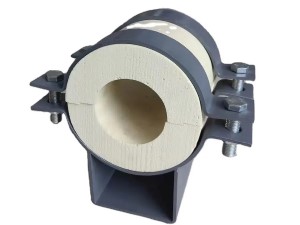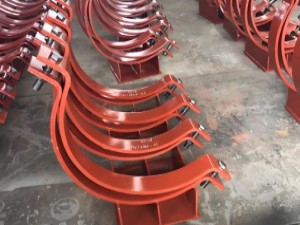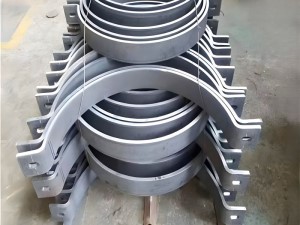ASTM A815 ~ S31803
Duplex stainless steels are extremely corrosion resistant, work hardenable alloys. Their microstructures consist of a mixture of austenite and ferrite phases.
As a result, duplex stainless steels display properties characteristic of both austenitic and ferritic stainless steels. This combination of properties can mean some
compromise when compared with pure austenitic and pure ferritic grades.
Duplex stainless steels are in most cases, tougher than ferritic stainless steels. Strengths of duplex stainless steels can in some cases be double that for austenitic stainless steels.
Whilst duplex stainless steels are considered resistant to stress corrosion cracking, they are not as resistant to this form of attack as ferritic stainless steels.
However, the corrosion resistance of the least resistant duplex stainless steels is greater than that for the most commonly used grades of stainless steels, i.e. 304 and 316.
Duplex steels are also magnetic, a property that can be used to easily differentiate them from common austenitic grades of stainless.
Property data given in this document is typical for flat rolled products covered by ASTM A240/A240M. ASTM, EN or other standards may cover products sold.
It is reasonable to expect specifications in these standards to be similar but not necessarily identical to those given in this datasheet.

Chemical Composition
Spec:
| Chemical Element |
% Present |
| Carbon (C) |
0.0 - 0.03 |
| Chromium (Cr) |
21.00 - 23.00 |
| Manganese (Mn) |
2.00 max |
| Silicon (Si) |
1.00 max |
| Phosphorous (P) |
0.0 - 0.03 |
| Sulphur (S) |
0.0 - 0.02 |
| Nickel (Ni) |
4.50 - 6.50 |
| Nitrogen (N) |
0.08 - 0.20 |
| Molybdenum (Mo) |
2.50 - 3.50 |
| Iron (Fe) |
Balance |
Properties
| Physical Property |
Value |
| Density |
7.805 g/cm³ |
| Thermal Expansion |
13.7 x10^-6 /K |
| Modulus of Elasticity |
200 GPa |
| Thermal Conductivity |
19.0 W/m.K |
| Electrical Resistivity |
0.085 x10^-6 Ω .m |
Spec:
-
| Mechanical Property |
Value |
| Proof Stress |
450 Min MPa |
| Tensile Strength |
620 Min MPa |
| Elongation A50 mm |
25 Min % |
| Hardness Brinell |
290 Max HB |

Alloy Designations
Grade UNS 31803 is similar to:
2205
EN 1.4462Z
UNS S31803
UNS S32205
BS 318S13
Supplied Forms
- Fittings & Flanges
- Pipe
- Plate
- Sheet
- Tube
- Bar
Applications
Duplex stainless steels are typically used in:
~ Chemical processing, transport and storage
~ Oil and gas exploration and offshore rigs
~ Oil and gas refining
~ Marine environments
~ Pollution control equipment
~ Pulp & paper manufacturing
~ Chemical process plant
Corrosion Resistance
Duplex stainless steels are extremely corrosion resistant. They have high resistance to intergranular corrosion.
Even in chloride and sulphide environments, duplex stainless steels exhibit very high resistance to stress corrosion cracking.
The super duplex grades are even more resistant to corrosion.
Heat Resistance
The high chromium content of duplex stainless steels that protects against corrosion, causes embrittlement at temperatures over about 300°C.
At low temperatures duplex stainless steels have better ductility than the ferritic and martensitic grades. Duplex grades can readily be used down to at least -50°C.
Fabrication
Fabrication of all stainless steels should be done only with tools dedicated to stainless steel materials. Tooling and work
surfaces must be thoroughly cleaned before use. These precautions are necessary to avoid cross contamination of stainless
steel by easily corroded metals that may discolour the surface of the fabricated product.
Machinability
Although machinable, the high strengths of duplex stainless steels makes machining difficult. As an example, machining of 2205 is around 20% slower than for 304.
Machining can be enhanced by using the following rules:
~ Cutting edges must be kept sharp. Dull edges cause excess work hardening.
~ Cuts should be light but deep enough to prevent work hardening by riding on the surface of the material.
~ Chip breakers should be employed to assist in ensuring swarf remains clear of the work
~ Low thermal conductivity of austenitic alloys results in heat concentrating at the cutting edges. This means coolants and lubricants are necessary and must be used in large quantities.
Heat Treatment
Duplex stainless steels cannot be hardened by heat treatment. They can however be work hardened.
Solution treatment or annealing can be done by rapid cooling after heating to around 1100°C.
Weldability
Duplex stainless steels have good weldability. All standard welding processes can be used. They are not quite as easily
welded as the austenitic grades but low thermal expansion in duplex grades reduces distortion and residual stresses after welding.
The recommended filler material for 2205 stainless steel is 2209.







